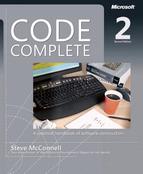The gap between the best software engineering practice and the average practice is very wide—perhaps wider than in any other engineering discipline. A tool that disseminates good practice would be important.
My primary concern in writing this book has been to narrow the gap between the knowledge of industry gurus and professors on the one hand and common commercial practice on the other. Many powerful programming techniques hide in journals and academic papers for years before trickling down to the programming public.
Although leading-edge software-development practice has advanced rapidly in recent years, common practice hasn't. Many programs are still buggy, late, and over budget, and many fail to satisfy the needs of their users. Researchers in both the software industry and academic settings have discovered effective practices that eliminate most of the programming problems that have been prevalent since the 1970s. Because these practices aren't often reported outside the pages of highly specialized technical journals, however, most programming organizations aren't yet using them today. Studies have found that it typically takes 5 to 15 years or more for a research development to make its way into commercial practice (Raghavan and Chand 1989, Rogers 1995, Parnas 1999). This handbook shortcuts the process, making key discoveries available to the average programmer now.
The research and programming experience collected in this handbook will help you to create higher-quality software and to do your work more quickly and with fewer problems. This book will give you insight into why you've had problems in the past and will show you how to avoid problems in the future. The programming practices described here will help you keep big projects under control and help you maintain and modify software successfully as the demands of your projects change.
This handbook serves experienced programmers who want a comprehensive, easy-to-use guide to software development. Because this book focuses on construction, the most familiar part of the software life cycle, it makes powerful software development techniques understandable to self-taught programmers as well as to programmers with formal training.
Many technical leads have used Code Complete to educate less-experienced programmers on their teams. You can also use it to fill your own knowledge gaps. If you're an experienced programmer, you might not agree with all my conclusions (and I would be surprised if you did), but if you read this book and think about each issue, only rarely will someone bring up a construction issue that you haven't previously considered.
If you haven't had much formal training, you're in good company. About 50,000 new developers enter the profession each year (BLS 2004, Hecker 2004), but only about 35,000 software-related degrees are awarded each year (NCES 2002). From these figures it's a short hop to the conclusion that many programmers don't receive a formal education in software development. Self-taught programmers are found in the emerging group of professionals—engineers, accountants, scientists, teachers, and smallbusiness owners—who program as part of their jobs but who do not necessarily view themselves as programmers. Regardless of the extent of your programming education, this handbook can give you insight into effective programming practices.
The counterpoint to the programmer with experience but little formal training is the fresh college graduate. The recent graduate is often rich in theoretical knowledge but poor in the practical know-how that goes into building production programs. The practical lore of good coding is often passed down slowly in the ritualistic tribal dances of software architects, project leads, analysts, and more-experienced programmers. Even more often, it's the product of the individual programmer's trials and errors. This book is an alternative to the slow workings of the traditional intellectual potlatch. It pulls together the helpful tips and effective development strategies previously available mainly by hunting and gathering from other people's experience. It's a hand up for the student making the transition from an academic environment to a professional one.
